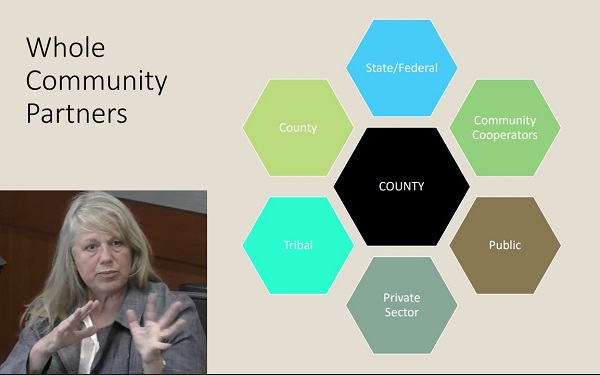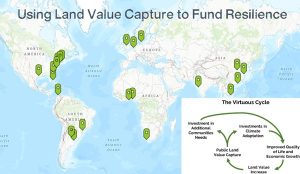County streamlines evacuation alerts ahead of fire season
8 min read
Presenter: This fire season, Lane County has new software that will reduce the time needed to issue evacuation alerts. With county commissioners July 9, Emergency Manager Tiffany Brown:
Tiffany Brown (Lane County, emergency manager): We have some new evacuation software that talks directly to our alerting system. I won’t get into the weeds on how it works, but it’s going to cut about 20 minutes of time from the time we’ve established what the evacuation area is and the time we’re able to send the alert out because the two systems talk to one another and the evacuation zones are pre-identified within the system.
[00:00:33] We also have the ability to edit those shapes. So no longer do we need to get somebody out of bed or over to the EOC (Emergency Operations Center) from GIS (Geographic Information Systems) to create the shape, to create the product, to go on the website. It all happens simultaneously and automatically within those two software systems, which are Genasys evacuation software and Everbridge, which powers our Lane Alerts. It’s a really exciting development.
[00:00:57] Presenter: They’ve already used the software in two incidents, the heavy rains and flooding in March and the Mapleton wildfire in June. Tiffany Brown:
[00:01:06] Tiffany Brown (Lane County, emergency manager): The Rice Road Fire in Mapleton, which got to not more than five acres, but you know, that Level 1 evacuation was in place for a few days, by design. You know, I had, I actually got a call from Watch Duty. You know, they call people. And they said, ‘Hey, you’re Level 1.’ That prompted—we’re going to have a meeting with them, Search and Rescue, and GIS and kind of understand more about how that all comes together and shows up.
[00:01:29] And so both of these events, particularly the Mapleton event, gave us real practice with the shapes and how the systems talk to one another. GIS still came to the table and we all kind of got our head around how it works.
[00:01:42] It immediately feeds RAPTOR, which is the real-time assessment tool at the state of Oregon—that live map on the state website. It’s a good tool. And so the minute we hit ‘Send,’ it shows up on the state map as a live evacuation.
[00:01:55] So this is a really important development in terms of timeliness. Now we have the fire chiefs and the sheriff’s office—everyone’s been going through the training for this software.
[00:02:05] Presenter: Commissioner Trieger asked about sharing alerts in different languages. Emergency Management is already working on it. Tiffany Brown:
[00:02:14] Tiffany Brown (Lane County, emergency manager): In the incident that we had in March with the flood, there was a neighborhood in Eugene and they had been displaced. And the question came up about translation.
[00:02:24] We’ve already had two meetings with Public Health to talk about not just finding translators and identifying who they are, but literally creating a position within the emergency management.
[00:02:36] Presenter: Commissioner Heather Buch:
[00:02:38] Commissioner Heather Buch: There are other states that require formal emergency management training of their elected officials. We do not have that equivalent in the state of Oregon, although I think it would be a really great idea. But it also begged the question for me of what kind of formal training should we be having as commissioners just because we are in a county that has incidents on a regular basis.
[00:03:07] Presenter: Tiffany recommended self-paced courses from FEMA available free online.
[00:03:12] Tiffany Brown (Lane County, emergency manager): Anybody that touches an emergency should take ICS 100, ICS 200 and ICS 700.
[00:03:19] (ICS) 100 and 200 start to get into the incident command system and I think it is a really good overview for anyone that touches a disaster to understand what’s happening around them.
[00:03:30] There are other recommendations that I could make, you know, understanding how the Emergency Operations Center works. It is the center of everything that we do.
[00:03:39] I know that a lot of this started with 9/11 and the inability to coordinate and communicate effectively. And that’s why we were given this system.
[00:03:46] I think the value of the ICS training is that when an incident occurs, we shift into an entirely different organizational system and model. And even people that have taken the course are still looking at their boss, even though they’re in a new model.
[00:04:01] And so I think it’s less about understanding it to navigate through it yourself, and just realizing that, ‘We’re in a new system now.’
[00:04:10] Presenter: The organizational model helps teams focus on specific objectives, safety, clear communication, and continuous improvement. Tiffany Brown:
[00:04:19] Tiffany Brown (Lane County, emergency manager): Operational coordination and communication are among the most important things that we do, and in fact you’ll look through the history and see incidents where communication is all we were doing. We have a cooperator’s call. We’ve activated the EOC. We may be coordinating some resources, but our primary function—maybe the most important reason we’re there—is that ‘information in, information out’ that we provide to the community as the hub of that emergency management function.
[00:04:45] Last summer we were on the ready and just having those cooperator calls—even when they boiled down to a couple of times a week when something did spring up—I really felt like we were more nimble, people had more muscle to be at the table and they realized, you know, ‘Oh, it’s not a, it’s not 45 minutes. It’s not this commitment. It’s just show up, hear the information at the same time.’
And so, that’s the intention: Not a lot of fluff, really, just the weather, what the local agencies are doing, and then anything regionally or statewide that’s happening that stands to impact us.
[00:05:17] There may be other things as we come along, but I want you to just know that’s the spirit of that communication… like, the verbal version of a situation report.
[00:05:27] Presenter: An after-action meeting lets teams share what went well, and where we can improve. Feedback after the ice storm showed the need for emergency shelter facilities distributed throughout the county. FEMA uses the term ‘mass care.’ Tiffany Brown:
[00:05:42] Tiffany Brown (Lane County, emergency manager): As you know, it was one of my key takeaways during the ice storm after-action, and my finding was, ‘Yes, we have some gaps, but that it was even difficult to have a conversation about it, based on the assumptions that people have about it.’ Language matters. You say the word ‘respite’ to five people, and it means five different things.
[00:06:00] And so the mass care assessment is designed as a strategic tool, to bring everyone with a responsibility around mass care to the table to help them understand their responsibility about mass care and then provide them with the opportunity to sort of unpack these questions, you know: ‘Who do you need to take care of? What resources do you have? What resources do you need?’
And to approach this project in a comprehensive fashion, which is to say: We understand how every person living in Lane County is accounted for under the umbrella of mass care.
[00:06:36] We got word a couple weeks ago, that we have received a $160,000 grant to perform a countywide mass care assessment that starts to answer the questions of: ‘Who are we talking about when we say we’re taking care of people? Where are they? What do they need? What are their challenges? Why do we care?’
[00:06:54] These are things that have popped up during wildfire season.
[00:06:57] So, we have a kickoff meeting with FEMA in two weeks to talk about this project.
[00:07:02] Presenter: The county had planned to upgrade community centers and schools to serve as mass care resources, but the federal funding was cut off. Tiffany Brown:
[00:07:11] Tiffany Brown (Lane County, emergency manager): The resilience hub grant, which looks like it’s not going to come to fruition, actually ended up having an indirect benefit. And that is the number of communities we had contact us when they heard about it, to say, ‘Can we be one?’ But they’re still excited about providing that kind of service in their community.
[00:07:31] I think ‘resilience hub’ is the new term. I think we won’t even be calling them ‘shelters’ in another five years. And so starting to promote that idea of: Red Cross in the county isn’t here to give you a shelter. We’re here to provide you with the resources and the subject matter expertise to help yourselves in a bad day, not because we don’t want to help, but because we understand that helping yourselves on that very bad day is actually the most effective way to take care of a community. So that’s exciting work.
[00:08:01] Presenter: Commissioner Pat Farr:
[00:08:02] Commissioner Pat Farr: In the days long before (former Emergency Manager) Patence (Winningham) and just shortly after (County Administrator) Steve Mokrohisky came here, we didn’t have any emergency response. I mean, it was, ‘ What do we do now?’ so what we’re seeing today is miraculous. It really is. And I’m looking directly in your eyes, and when I say: You’re performing miracles.
[00:08:18] We had our first meeting, Steve Dingle brought us all together just so that commissioners knew how to get a hold of each other in case it was an emergency. We didn’t even have that level. But we’re very sophisticated now.
[00:08:28] But the point I want to make is that in the case of an event—a large event that spans the lighthouse to the volcanoes—the importance of the single countywide agency, the sheriff’s department. Let’s focus on that. We’re vastly under-resourced there. We can’t even do patrol and 911 response. And we do rely on the sheriff immensely, both by design and by default to cover an emergency.
[00:08:54] So I don’t need an answer to that at this point in time, but just to understand that as we look to funding the sheriff’s department, we’re not just funding patrol. We’re not just funding corrections. We’re funding this all-important function of the sheriff’s department, so thanks.
[00:09:07] Tiffany Brown (Lane County, emergency manager): Absolutely, and I think it’s because you’ve had so much practice and everyone’s worked so well together and that we are able to do so, so much and do so well with the few people that we have.
[00:09:18] Commissioner Pat Farr: And they’ve, for many, many years, always, since before (Sheriff Russel E.) Burger, they’ve done more with less in the sheriff’s department. They’re accustomed to that tight belt and lean. But imagine what they could do with more resources.
[00:09:29] Tiffany Brown (Lane County, emergency manager): Yeah. Thank you.
[00:09:32] Presenter: Lane County emergency management streamlines its evacuation alert system, and adopts community feedback after the ice storm to start assessing countywide needs for emergency shelter.
[00:09:44] One important way that you can prepare for wildfires this summer is by signing up at the Lane County website for Lane Alerts.






